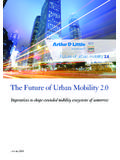Transcription of Closing the gap - Leonard Cheshire Disability
1 Closing the gap Inclusive education for girls with disabilities in Kenya Leonard Cheshire Closing the Gap 1. Education is one of the most powerful and proven vehicles for sustainable development. Contents 1. A bit about us and our inclusive education programme 4. 2. How our programme works a sustainable model 8. Between 2000 and 2014, the global 3. Overcoming barriers what we have achieved 9 number of out-of-school children at primary education level dropped 4. The lessons we've learned 26 from 100 million to 61 million. While this represents significant progress, 5. Looking to the future 30 approximately one third of children that remain out of school are children with a The barriers experienced as a result of Disability are amplified by other factors including race, gender and poverty.
2 Disability and gender are considered among the most influential causes of marginalisation in education. Their intersection places girls with disabilities most at risk of never entering or completing their education. They are also more likely to experience isolation, stigmatisation, exclusion from community life and It is clear that there is still significant work to be done in order to achieve the aim of Sustainable Development Goal Four: Ensure inclusive and equitable quality education and promote lifelong learning opportunities for all'. Progress on girls'. education, especially for disabled girls, is critical to eliminating gender and wealth disparities and establishing equal access to quality, inclusive education.
3 This report outlines the impact of Leonard Cheshire 's inclusive education project in Kenya, funded by the UK Department for International Development's Girls' Education Challenge'. Delivered over four years, the project supported over 2,000 girls with disabilities across the Nyanza Lake Region of Kenya to enrol in primary school. Through highlighting what was achieved, along with lessons learned, we hope to support the design and delivery of future inclusive education projects and help create the systemic change required to meet the ambition of education for all. Leonard Cheshire International Department 66 South Lambeth Road London SW8 1RL 1 UNESCO (2006) Strong Foundations: Early Childhood Care and Education, EFA Global Monitoring Report 2007, Paris: UNESCO ( ).
4 +44 (0)20 3242 0200. 2 UNESCO (2015) Education for All 2000 2015: Achievements and Challenges, EFA Global Monitoring Report 2015, Paris: UNESCO ( ). Visit: 2 Closing the Gap Leonard Cheshire Leonard Cheshire Closing the Gap 3. Definitions 1. A bit about us Inclusive education is based on the concept that education and our inclusive should address and respond to the diverse needs of all learners. This is done through increasing participation in learning, cultures and communities, and reducing exclusion education within and from education. programme This approach is distinct from special education, which places children with disabilities in specialist schools, excluding them from the community and mainstream education.
5 And integrated education, which recognises the benefits of children with disabilities attending mainstream schools, but separates learners into specialist classes or units. Who we are Our inclusive education Teacher/School Management programme Committee/Head Leonard Cheshire supports individuals to live, learn and work as independently as teacher training Inclusive education is a core programme on how to support they choose, whatever their ability. Led within Leonard Cheshire 's global work. children with by people with experience of Disability , Children with disabilities face a range of disabilities we are at the heart of local life opening barriers to accessing and remaining in doors to opportunity, choice and support education including: across the globe.
6 Creating an accessible n Attitudinal and behavioural barriers related to Child identification, Like our founder, we believe that diversity assessment and and inclusive learning social norms creates a world of possibility. Through pioneering support environment n Infrastructural and environmental barriers research and innovation we're building a fairer, n Policy barriers more inclusive society. One that recognises the positive contributions we all make, and where we are all proud to play our part. n Resource barriers Children We support more than 30,000 people with Our model delivers a range of interventions to address these barriers.
7 We take a systems with disabilities in the UK and around the world each year. With our partners in Africa and approach, working to create sustainable change at an individual, community, school and policy disabilities Asia, we provide inclusive education and level, both locally and nationally. livelihoods programmes that support people with disabilities in 15 countries. We also research Parents, family and Disability and poverty, and work with the United Child-to-Child community Nations, national governments, Disability activities awareness organisations and development actors to influence policy and make sure everyone has the opportunity to live as they choose.
8 Working with local civil society and government on institutionalising Figure 1: Leonard inclusive education Cheshire 's inclusive education model 4 Closing the Gap Leonard Cheshire Leonard Cheshire Closing the Gap 5. Pioneering inclusive In order to help address these issues, Leonard Cheshire secured funding from the UK. education strategies for Department for International Development's disabled girls in Kenya Girls' Education Challenge'. Funds were allocated to implement our inclusive education In Kenya, people with disabilities are among model across 50 schools in the Nyanza Lake the most marginalised, socially excluded and Region of Kenya, one of the poorest regions poorest groups.
9 Children with disabilities are of the Delivered over four years from routinely denied access to a meaningful, quality 2013 2017, the project aimed to support 2,050. education and this affects girls disproportionally girls with disabilities to enrol in primary school as more than their male counterparts. In 2003, well as achieving: Kenya introduced a policy of universal free n Increased awareness and capacity of duty- primary education. While overall enrolment in bearers and service providers to respond to primary education has increased since then, the needs of disabled girls the number of girls with disabilities accessing primary schools has remained low and the n A sustained improvement in the enrolment, Who took part?
10 Number dropping out is increasing. attendance and retention of disabled girls in mainstream primary schools The majority of the girls were aged from 7 19, with an average age of 12 years old. They had a In Kenya, girls with disabilities are inhibited n Improved quality and accessibility of wide range of disabilities and impairments. The education level of the girls was evenly split with from attending and remaining in school due mainstream education for disabled girls, approximately 10% of the group in each school grade from pre-school through to Class 8. to multiple and often intersecting barriers, resulting in improved learning outcomes including: n Improved knowledge and evidence to n Limited access to rehabilitation services and demonstrate the effectiveness of inclusive 15% 15%.




